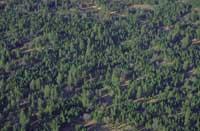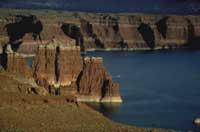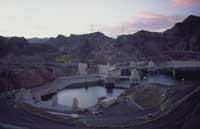Grand Canyon: the real Grand Canyon
What will the Grand Canyon look like?
The Colorado River is the longest west of the Rocky Mountains and in 2,334 kilometers of travel drains an extensive basin in the states of Wyoming, Colorado, Utah, Nevada, New Mexico and Arizona, before it is poured into the Gulf of California. In the first 1,600 km of the route, the flow force has dug several barrels and cannons. The most famous, of course, is the Grand Canyon, the Grand Canyon, located in Arizona.

The mud and sediments that the river carries provide a red color to the water, so it was called Colorado. However, the old muddy red forest of the Colorado River has virtually disappeared in its entirety, in the current river braked and managed for eleven years. In fact, although the water stream carries 40,000 tons of sediments per day through the Grand Canyon, this amount is little compared to the loads it was carrying before the reservoirs were built: From 380.000 to 500.000 tons daily. We were also the flows: 3,360 to 8,400 m3/s.
The Great Foz of the Colorado River is whatever the surprising, with an average width of 16 km and a depth of 1.6 km. The Grand Canyon has a length of 446 km and in this stretch the Colorado River descends 570 m, that is, more than one meter per km or, to express otherwise, 25 times more than the Mississippi. About half of this descent occurs in the strong flames of water, although its length is only nine percent of the total canyon; along the Grand Canyon there are 161 waters. The speed of water in the torrent is 6.5 km/h and can reach 16 km/h in the fastest waters.

However, the most fascinating thing is the vision of the head towards the bottom: the eye, which on the face moves through the rock layer, which begins today and is delayed almost 2000 million years in time, an incredible geological journey in a flicker. An almost cosmic vertigo, indeed. How to explain it? It is not easy. The canyon has not always been there, nor has Colorado always been there. And in fact, there are two canyons, one inside the wider canyon (the so-called outer canyon), the one corresponding to the riverbed (the inner canyon), plus, of course, all the side tax barrels. The first and main one has lasted for almost 2000 million years, giving rise to its entire territory. Then, about 6-30 million years ago, the Colorado River began to dig the canyon and to it we owe that retrospective virtual journey in time, until the time when the Earth was so young.
The most visible or, at least, best known part of the Grand Canyon is protected as the Grand Canyon National Park, embracing a total width of 4.925 km2 (measured from 1975), that is, a park of approximate size of Alava plus Bizkaia. In addition, the entire surrounding territory is somehow in the germ of the law, within different legal figures: the national forest, the national lacquered area or the reserve of Indians. Therefore, the Grand Canyon is a large extension area.
In this enclosure you can find different types of living things, such as 70 species of mammals, 280 species of birds (of which 40 are year-round inhabitants), 44 species of reptiles and amphibians, and seven species of fish; in the list of plants there are more than 200 trees, shrubs, flowers, cactus and ferns. The great complexity of the living beings mentioned is a consequence of the different ecological zones presented by Grand Canyon and which, of course, delimits above all the heights, geology and climates, which are impacted from top to bottom. The ascent from the river to the amilburu is, as for the medium, like a journey in latitude of 3000 km, from the desert of Sonora in the north of Mexico to that of Calgary in Canada. We left in the riparian community of the river bank and crossed the biological communities of the desert, we reached the boreal and suballenera community. Let us remember that along the steep slopes of the Arbaiun foz there is also a latitudinal gradation, although otherwise more modest.
American monuments

So far we have highlighted the geological and biological characteristics of the Grand Canyon, among which implicitly highlights the total simplicity of this wonderful territory. Together with them, we have made clear that the main core has the category of national park, that is, the maximum protection of the United States. In addition, it has this category from 1919, so we can think quite easily that long ago came the responsibility to preserve this natural space and, according to him, the corresponding legislative support.
But it was not because, in principle, without a conservationist concern, American cultural nationalism was the main driver of national parks, the search for cultural identity. And it is in this textual context that the legal figure of protection recognized in 1906 by the United States Congress, the national monument, is framed. In fact, from 1908 the Grand Canyon was a national monument, like a European Gothic cathedral in the same way as a monument. President Roosevelt declared an area of 3,000 km2 of the Arizona Grand Canyon a national monument, according to which the "textbook" of erosion and stratification was unbeatable worldwide.
Unlike the Yellowstone and Yosemite national parks, it was clear that the Grand Canyon was of value, that it could not obtain any profitable benefit from it. Obviously, this seemingly unexploitable character facilitated the theme of the denomination, since there was no direct opposite economic interest. Probably the process would have been much more uneven if in those years more was known about the capacity of accumulation of water and the production of hydroelectric force of rivers and canyons.
In fact, the Colorado River crosses an extensive yet arid territory, and ultimately awaits the insatiable tap of thirsty California. Thus, Colorado and other states in the upper zone of the basin were knots if they were not going to lose their share. This led to a series of vicissitudes that, while known as the "water war," did not conform to those occurring in the Middle East to control the flow of the Jordan River. The truth is that in 1922 it was decided that the states of Colorado, New Mexico, Utah and Wyoming would emit 9.250 million m3 of water per year for the lower, Arizona, Nevada and California. And as liver, of course, many reservoirs have been built, both in the main river and in the branches.

Among the most representative of these reservoirs are Hoover Dam and Glen Canyon Dam, inaugurated in 1935 and 1963 respectively. In addition to being one of the largest in the world, they border the Grand Canyon above and below: The Grand Canyon National Park starts practically in the same atrium of the Glen Canyon Reservoir and ends 450 km. below, just at the point where the water accumulated by Hoover Dame, known as Lake Mead, arrives.
It should be noted, moreover, that in the early years of the 1960s two other construction reservoirs were projected within the Gran Cañilla, regardless of the nature of the national park. And the reasons why these two great projects were abandoned during those years were not favorable to ecology but to the loss of a supreme monument.
Grand Canyon Problems
The national parks of the United States have by law two objectives: to preside over the resource and to ensure the pleasure of the people. However, this double objective is becoming increasingly scarce as the number of visitors increases.
After President Theodore Roosevelt declared the Grand Canyon a national park, each of the true Americans (every true American) had the patriotic need to attend the pilgrimage, thus unifying the cultural nationalism and economic interest of the See America First campaign. That is, the amount of money that was spent every year abroad (about 500 million dollars of that time) had to be spent inside the house, since, undoubtedly, there were the most ejected corners of the world.

In 1919, 44,000 people approached the Grand Canyon, which by 1947 was more than 500,000. However, the number of visitors has multiplied above all measures, from one million in 1956 to two in 1969 and three million in 1976.
As the figures rise, in 1993 five million people visited the Grand Canyon, to the North (20%) or to the South (80%), of which more than a million have dared to tour the ravine along trails and trails of the area.
On the other hand, 26,000 people descended the river in the form of rafting, despite the serious risks of sewage and annual deaths. And another 800,000 people saw the park as eagles, both by plane and helicopter. In the summer months you can see up to six thousand cars a day, without stopping to turn, to conquer one of the 2,500 parking spaces that are in everything. There are also more than a hundred buses per day.
In this sense, the current great challenge of the Grand Canyon National Park is undoubtedly the management of this wave of visitors that has completely surpassed the structure of the park, how to channel this huge crowd and, at the same time, witness the natural space? We must not forget that by 2000 seven million visitors have been rubbed. As has ever been said, the Grand Canyo will die with love among all. However, to the farthest places and far from the Great Foz, other harmful agents have reached the occlusions that will not reach anyone.

On the one hand, air pollution of a few days is incredible and reduces average annual visibility by 30%, while in some winter days visibility is reduced by 70% almost completely eliminating the spectacular view of the Grand Canyon. The main causes are the smoke clouds of Los Angeles and Phoenix, as well as the coal plants of Page (Arizona) and Four Corners (New Mexico). For example, the Page plant provides 240 tons of sulfur dioxide per day.
On the other hand, we have the noise, an element of invisible balance that enters until the most lost Thursdays of the Grand Canyon. In fact, although the buzzing engines of cars and buses originate in a single road of the park, they extend profoundly with echoes. However, the most important source of noise are small planes and, above all, helicopters for the takeoff of spectators, whose area of influence extends throughout the width of the park. In parallel, there is a high frequency of flights and in the busiest days an airplane is emitted per minute. Logically, a series of measures and restrictions have been proposed to reduce current noise levels and, incidentally, avoid air accidents that have so far occurred.
The Colorado River itself has undergone a series of brutal changes during these years. Since the construction of the Glen Canyon reservoir, the terrible annual floods have replaced small daily tides, in fact the river grows at most four meters according to the demands (140-560 m3 of discharge from the reservoir). The water is now much colder as it comes from the depth of the reservoir. It is also cleaner and the solar rays are internalized, so that a new food chain has been formed: The Cladophora algae has attracted diatoms, which are the amphipod Gammarus, which is the food of trout and which, in turn, feeds on trout to the burusoil eagle.

The vegetation has grown on the banks and on the sand bars of the river, as the floods no longer destroy it. The exotic millennium and the native willow have proliferated, lined with countless bugs; migratory birds have long realized the new food source and in its ravine came the peregrine falcon, with a nesting population in the Grand Canyon.
Obviously, the Glen Canyon reservoir has meant a substantial change in the Grand Canyon river ecosystem. By default, we may think that this change has been positive, as biodiversity has increased. However, according to data, the cold water has cleaned at least three species of local fish and what locals call “humpback chub½ is in a very serious situation. Despite everything, the Grand Canyon has survived a monumental vision, but it sees a very short future as a complete ecosystem.





